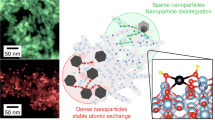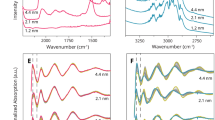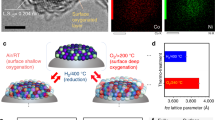Abstract
Understanding and improving the behaviour of supported precious-metal catalysts for a vast array of environmentally and economically important processes is a central area of research in catalysis. The removal of toxic gases such as CO and NO, without forming others (such as N2O), is particularly important. By combining energy-dispersive extended X-ray absorption fine-structure spectroscopy with a vibrational spectroscopy (infrared) and mass spectrometry, at high time resolution, in a single in situ experiment, we dynamically observe and quantify CO-, and subsequent NO-, induced size and shape changes of Pd nanoparticles during CO/NO cycling. In doing so we demonstrate a novel, non-oxidative redispersion (for example, an increase in metal surface area) mechanism, and suggest a model to bridge the structural and reactive functions of supported Pd catalysts.
This is a preview of subscription content, access via your institution
Access options
Subscribe to this journal
Receive 12 print issues and online access
$259.00 per year
only $21.58 per issue
Buy this article
- Purchase on Springer Link
- Instant access to full article PDF
Prices may be subject to local taxes which are calculated during checkout




Similar content being viewed by others
References
Dalla Betta, R. A., McCuney, R. C. & Sprys, J. W. Relative importance of thermal and chemical deactivation of noble metal automotive oxidation catalysts. Ind. Eng. Chem. Prod. Res. Dev. 15, 169–172 (1976).
Che, M. & Bennett, C. O. The influence of particle size on the catalytic properties of supported metals. Adv. Catal. 36, 55–172 (1989).
Leiske, H., Lietz, G., Spindler, H. & Volter, J. Reactions of platinum in oxygen treated and hydrogen treated Pt-γAl2O3 catalysts 1. Temperature programmed reduction, adsorption and redispersion of platinum. J. Catal. 81, 8–16 (1983).
Leiske, H., Lietz, G., Spindler, H., Hanke, W. & Volter, J. Reactions of Platinum in oxygen treated and hydrogen treated Pt-γAl2O3 catalysts 2. Ultraviolet visible studies, sintering of platinum, and soluble platinum. J. Catal. 81, 17–25 (1983).
Birgersson, H., Eriksson, L., Boutonnet, M. & Jaras, S.G. Thermal gas treatment to regenerate spent automotive three-way exhaust catalysts (TWC). Appl. Catal. B 54, 193–200 (2004).
Cabello-Galisteo, et al. Reactivation of sintered Pt/Al2O3 oxidation catalysts. Appl. Catal. B 59, 227–223 (2005).
Daley, R. A., Christou, S. Y., Efstathiou, A. M. & Anderson, J. A. Influence of oxychlorination treatments on the redox and oxygen storage and release properties of thermally aged Pd–Rh/CexZr1−xO2/Al2O3 model three-way catalysts. Appl. Catal. B 60, 2117–227 (2005).
Harris, P. J. F. Sulphur-induced faceting of platinum catalyst particles. Nature 323, 792–794 (1986).
Hansen, P. L. et al. Atomic resolved imaging of dynamic shape changes in supported copper nanocrystals. Science 205, 2053–2055 (2002).
Hendriksen, B. L. M., Bobaru, S. S. & Frenken, J. W. M. Oscillatory CO oxidation on Pd(100) studied with in situ scanning tunneling microscopy. Surf. Sci. 552, 229–242 (2004).
Lu, J.-L. et al. Low temperature CO induced growth of Pd supported on a monolayer silica film. Surf. Sci. Lett. 600, L153–L157 (2006).
Howard, A., Mitchell, C. E. J. & Edgel, R. E. Real time STM observation of Ostwald ripening of Pd nanoparticles on TiO2(110) at elevated temperatures. Surf. Sci. Lett. 515, L504–508 (2002).
Stone, P., Poulston, S., Bennett, R. A. & Bowker, M. Scanning tunnelling microscopy investigation of sintering in a model supported catalyst: nanoscale Pd on TiO2(110). Chem. Commun. 1369–1370 (1998).
Schalow, T. et al. Size-dependent oxidation mechanism of supported Pd nanoparticles. Angew. Chem. Int. Edn. 45, 3693–3697 (2006).
Farrauto, R. J. & Heck, R. M. Catalytic converters: State of the art and perspectives. Catal. Today 51, 351–360 (1999).
Huber, B., Kosinen, P., Hakkinen, H. & Moseler, M. Oxidation of magnesia-supported Pd-clusters leads to the ultimate limit of epitaxy with a catalytic function. Nature Mater. 5, 44–47 (2006).
Jentys, A. Estimation of mean size and shape of small metal particles by EXAFS. Phys. Chem. Chem. Phys. 1, 4059–4063 (1999).
Newton, M. A., Dent, A. J. & Evans, J. Bringing time resolution to EXAFS: Recent developments and application to chemical systems. Chem. Soc. Rev. 31, 83–95 (2002).
Fernandez-Garcia, M. et al. New Pd/CexZr1−xO2/Al2O3 three-way catalysts prepared by microemulsion—Part 1. Characterization and catalytic behaviour for CO oxidation. Appl. Catal. B 31, 39–50 (2001).
Martinez-Arias, A. et al. New Pd/CexZr1−xO2/Al2O3 three-way catalysts prepared by microemulsion—Part 2. In situ analysis of CO oxidation and NO reduction, under stoichiometric CO+NO+O2 . Appl. Catal. B 31, 51–60 (2001).
Iglesias-Juez, A., Martínez-Arias, A., Newton, M. A., Fiddy, S. G. & Fernández-García, M. Redox behaviour of Pd-based TWCs under dynamic conditions: Analysis using dispersive XAS and mass spectrometry. Chem. Commun. 4092–4094 (2005).
Newton, M. A., Fiddy, S. G., Guilera, G., Jyoti, B. & Evans, J. Oxidation/reduction kinetics of supported Rh/Rh2O3 nanoparticles under plug flow conditions using dispersive EXAFS. Chem. Commun. 118–119 (2005).
Heiz, U. & Bullock, E. L. Fundamental aspects of catalysis on supported metal clusters. J. Mater. Chem. 14, 564–577 (2004).
Solymosi, F. & Banasagi, T. On the participation of NCO surface species in the NO+CO reaction. J. Catal. 202, 205–206 (2001).
Newton, M. A., Dent, A. J., Fiddy, S. G., Jyoti, B. & Evans, J. Combining diffuse reflectance spectroscopy (DRIFTS), dispersive EXAFS, and mass spectrometry with high time resolution: potential, limitations, and application to the study of the interaction of NO with supported Rh catalysts. Catal. Today doi:10.1016/j.cattod.2006.09.034 (2006).
Newton, M., A., Dent, A. J., Fiddy, S. G., Jyoti, B. & Evans, J. Identification of the surface species responsible for N2O formation from the chemisorption of NO on Rh/alumina. Phys. Chem. Chem. Phys. 9, 246–249 (2007).
Newton, M. A. Beamsize related phenomena and effective normalisation in energy dispersive EXAFS for the study of heterogeneous catalysts, powder materials, and the processes they mediate: Observations, and (some) solutions. J. Synchrotron Rad. (in the press).
Acknowledgements
The authors would like to thank the ESRF for access to facilities and for the funding that permitted the development of this experiment on ID24. T. Mairs, F. Perrin, G. Guilera and A. Kroner are thanked for the various contributions they have made to this work; S. Pascarelli and O. Mathon are thanked for their general support and stewardship of the beamline. Finally, we acknowledge the CYCIT (projects CTQ2004-03409/BQU and CTQ2006-15600/BQU) for financial support. C. Belver thanks the Spanish ‘Ministerio de Educación y Ciencia’ for a ‘Juan de la Cierva’ postdoctoral grant.
Author information
Authors and Affiliations
Corresponding authors
Ethics declarations
Competing interests
The authors declare no competing financial interests.
Supplementary information
Supplementary Information
Supplementary information, table S1 and figures S1-S2 (PDF 161 kb)
Rights and permissions
About this article
Cite this article
Newton, M., Belver-Coldeira, C., Martínez-Arias, A. et al. Dynamic in situ observation of rapid size and shape change of supported Pd nanoparticles during CO/NO cycling. Nature Mater 6, 528–532 (2007). https://doi.org/10.1038/nmat1924
Received:
Accepted:
Published:
Issue Date:
DOI: https://doi.org/10.1038/nmat1924
This article is cited by
-
Deducing subnanometer cluster size and shape distributions of heterogeneous supported catalysts
Nature Communications (2023)
-
Evolution of Surface Structure on Pd–Cl/Alumina Catalyst During CO Purification Process
Catalysis Letters (2023)
-
Metal–organic frameworks derived Ce0.3Ni0.7Ox carrier improve Pd dispersion and three-way catalytic performance
Reaction Kinetics, Mechanisms and Catalysis (2023)
-
Catalytic Potential and Utility of High Entropy Alloys
Transactions of the Indian National Academy of Engineering (2023)
-
Infrared spectroscopy data- and physics-driven machine learning for characterizing surface microstructure of complex materials
Nature Communications (2020)



